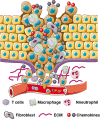The Roles of Stroma-Derived Chemokine in Different Stages of Cancer Metastases
- PMID: 33414786
- PMCID: PMC7783453
- DOI: 10.3389/fimmu.2020.598532
The Roles of Stroma-Derived Chemokine in Different Stages of Cancer Metastases
Abstract
The intricate interplay between malignant cells and host cellular and non-cellular components play crucial role in different stages of tumor development, progression, and metastases. Tumor and stromal cells communicate to each other through receptors such as integrins and secretion of signaling molecules like growth factors, cytokines, chemokines and inflammatory mediators. Chemokines mediated signaling pathways have emerged as major mechanisms underlying multifaceted roles played by host cells during tumor progression. In response to tumor stimuli, host cells-derived chemokines further activates signaling cascades that support the ability of tumor cells to invade surrounding basement membrane and extra-cellular matrix. The host-derived chemokines act on endothelial cells to increase their permeability and facilitate tumor cells intravasation and extravasation. The tumor cells-host neutrophils interaction within the vasculature initiates chemokines driven recruitment of inflammatory cells that protects circulatory tumor cells from immune attack. Chemokines secreted by tumor cells and stromal immune and non-immune cells within the tumor microenvironment enter the circulation and are responsible for formation of a "pre-metastatic niche" like a "soil" in distant organs whereby circulating tumor cells "seed' and colonize, leading to formation of metastatic foci. Given the importance of host derived chemokines in cancer progression and metastases several drugs like Mogamulizumab, Plerixafor, Repertaxin among others are part of ongoing clinical trial which target chemokines and their receptors against cancer pathogenesis. In this review, we focus on recent advances in understanding the complexity of chemokines network in tumor microenvironment, with an emphasis on chemokines secreted from host cells. We especially summarize the role of host-derived chemokines in different stages of metastases, including invasion, dissemination, migration into the vasculature, and seeding into the pre-metastatic niche. We finally provide a brief description of prospective drugs that target chemokines in different clinical trials against cancer.
Keywords: cancer; chemokines; invasion; metastases; metastatic niche; stroma.
Copyright © 2020 Hussain, Peng, Cherian, Song, Ahirwar and Ganju.
Conflict of interest statement
The authors declare that the research was conducted in the absence of any commercial or financial relationships that could be construed as a potential conflict of interest.
Figures



Similar articles
-
Tumor-Stroma-Inflammation Networks Promote Pro-metastatic Chemokines and Aggressiveness Characteristics in Triple-Negative Breast Cancer.Front Immunol. 2019 Apr 12;10:757. doi: 10.3389/fimmu.2019.00757. eCollection 2019. Front Immunol. 2019. PMID: 31031757 Free PMC article.
-
Cancer associated fibroblasts: phenotypic and functional heterogeneity.Front Biosci (Landmark Ed). 2020 Mar 1;25(5):961-978. doi: 10.2741/4843. Front Biosci (Landmark Ed). 2020. PMID: 32114420 Review.
-
Modern views on the role of main components of stroma and tumor microinvironment in invasion, migration and metastasis.Exp Oncol. 2020 Dec;42(4):252-262. doi: 10.32471/exp-oncology.2312-8852.vol-42-no-4.15401. Exp Oncol. 2020. PMID: 33355867 Review.
-
The matrix environmental and cell mechanical properties regulate cell migration and contribute to the invasive phenotype of cancer cells.Rep Prog Phys. 2019 Jun;82(6):064602. doi: 10.1088/1361-6633/ab1628. Epub 2019 Apr 4. Rep Prog Phys. 2019. PMID: 30947151 Review.
-
The role of tumor microenvironment in collective tumor cell invasion.Future Oncol. 2017 May;13(11):991-1002. doi: 10.2217/fon-2016-0501. Epub 2017 Jan 11. Future Oncol. 2017. PMID: 28075171 Review.
Cited by
-
Prognostic biomarker MCP-4 triggers epithelial-mesenchymal transition via the p38 MAPK pathway in ovarian cancer.Front Oncol. 2022 Dec 1;12:1034737. doi: 10.3389/fonc.2022.1034737. eCollection 2022. Front Oncol. 2022. PMID: 36531002 Free PMC article.
-
The Role of Different Immunocompetent Cell Populations in the Pathogenesis of Head and Neck Cancer-Regulatory Mechanisms of Pro- and Anti-Cancer Activity and Their Impact on Immunotherapy.Cancers (Basel). 2023 Mar 7;15(6):1642. doi: 10.3390/cancers15061642. Cancers (Basel). 2023. PMID: 36980527 Free PMC article. Review.
-
SMOX expression predicts the prognosis of non-small cell lung cancer.Ann Transl Med. 2021 Jul;9(13):1048. doi: 10.21037/atm-21-998. Ann Transl Med. 2021. PMID: 34422960 Free PMC article.
-
The Use of Iron Oxide Nanoparticles to Reprogram Macrophage Responses and the Immunological Tumor Microenvironment.Front Immunol. 2021 Jun 9;12:693709. doi: 10.3389/fimmu.2021.693709. eCollection 2021. Front Immunol. 2021. PMID: 34177955 Free PMC article. Review.
-
Development and Characterization of 3D Hybrid Spheroids for the Investigation of the Crosstalk Between B-Cell Non-Hodgkin Lymphomas and Mesenchymal Stromal Cells.Onco Targets Ther. 2022 Jun 17;15:683-697. doi: 10.2147/OTT.S363994. eCollection 2022. Onco Targets Ther. 2022. PMID: 35747403 Free PMC article.
References
-
- Kojima Y, Acar A, Eaton EN, Mellody KT, Scheel C, Ben-Porath I, et al. Autocrine TGF-beta and stromal cell-derived factor-1 (SDF-1) signaling drives the evolution of tumor-promoting mammary stromal myofibroblasts. Proc Natl Acad Sci U S A (2010) 107(46):20009–14. 10.1073/pnas.1013805107 - DOI - PMC - PubMed
Publication types
MeSH terms
Substances
Grants and funding
LinkOut - more resources
Full Text Sources
Medical

